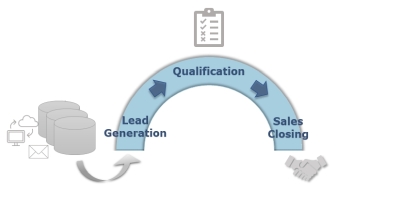Outbound Calling — The Basics
Although every business has tailored strategies and operational procedures to match them, there are some basic concepts that form the foundation of a well–thought strategy, a well–planned process, and a well–executed operation. So, let us touch on some concepts and a few ideas behind them, which perhaps will help you define, validate, or fine–tune your strategy.
Outbound calls may be used for different types of objectives, including outbound sales, marketing, collections, political campaigns, and donation campaigns, among others. But in essence, they all go through a similar set of steps, although the steps themselves may differ on how they are prepared, executed, and measured. In this conversation we will use mostly outbound sales as use case, but we should be able to easily translate and permutate concepts and steps for other cases.
When we look at outbound sales as a whole, we usually go through some key stages, from lead generation to qualification and sales closing. Specific business processes may add a few more within or between these, while others may combine one or more. There is also, of course, post-sales handling, which may or may not be in the scope of a particular operation. And on top of that, a more comprehensive business solution may include the total customer experience or customer lifecycle. But for now, let us just focus on the stages that mostly pertain to outbound calling.
The reason we mentioned these stages of outbound sales is because to maximize efficiency and efficacy, different strategies are usually applied depending on the objective of each stage or activity and how you measure its success. Also, a particular business may only handle a subset of outbound sales and therefore its strategy becomes even more focused. For example, a business or department may only care about lead generation, with its output offered to another business or department that handles qualification and perhaps also sales closing.
Lead generation takes a universe of contacts to filter it into a subset of contacts that have potential to be qualified. It may take many forms and it may produce different degrees of quality. The target output can range anywhere from mass data with nothing more than correct contact information to very specific demographics that meet stringent criteria. It may favor volume against criteria matching, the inverse, or something in between.
Qualification uses those leads to determine which contacts meet the criteria that can allow a transaction to be executed. It identifies the best targets for a successful transaction. By qualifying the likelihood of your contacts to execute a transaction, you can prioritize your contacts and maximize results. There are many ways into which qualification can take form, from calling the contact to verify it is indeed the correct contact, all the way to determining that the contact is willing or ready to engage.
The efficiency and efficacy of qualification is highly dependent on the quality of leads generated. It therefore becomes a balancing act to determine what resources to invest in lead generation and what resources to invest in qualification.
Sales closing handles qualified contacts to execute transactions. A properly qualified lead should lead to a successful sale close, where the focus is on the details and extent of the sale. This could be a product purchase or a service agreement, a completed collection transaction, a donation commitment, a successful political message and call to action, or whatever the target of the campaign may be.
Just like qualification is affected by lead generation, the efficiency and effectiveness of sales closing depends on an appropriate qualification process.
When looking to reach our contacts, we need to constantly look for ways to improve both efficiency and efficacy in order to maximize results at the least cost possible, sensitive, as well, to regulations and customer sentiment. There are a number of factors that must be accounted for, configured, measured, and revisited constantly to adapt to changing dynamics and latest results. We need to consider things like quantity of leads, quality of leads, number of agents, agent skills, priorities, operation hours, number of telephone lines, call volume, drop rates, and more.
It is a balancing act that needs careful planning, fine-tuning of as many variables as possible, collecting and analyzing results over time, and constantly adapting. Each business case will have its own specific target, requirements, and restrictions, but at the end of the day the tool needs are about the same, and it is mostly about how flexible your tool is and how much you can make it work for you.
Check back with us constantly as we write more about concepts, ideas, and strategies that we are sure to make you think about how to make your business even better. See you again soon!

